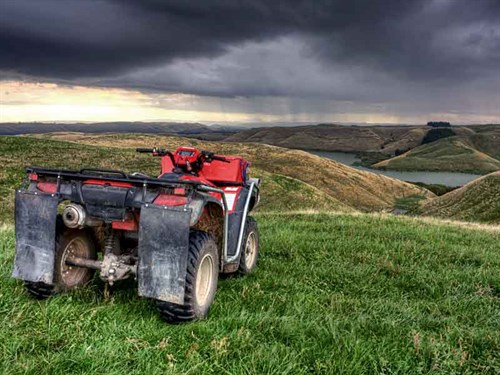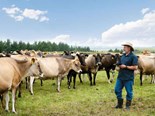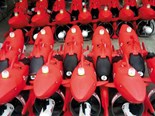Farm Bike Safety: Safe use of quad bikes
WorkSafe New Zealand offers a detailed safety plan, covering everything from useage to maintenance, to protect both bike users and the bike
On average, five people are killed on New Zealand farms each year in work-related quad bike incidents. In addition, there are more than 100 severe injuries each year on New Zealand farms.

Quad bike riding skills need to be learned through riding experience and training. Riders who are unfamiliar with the particular quad bike or farm terrain, and/or unskilled in the proper active riding techniques are at increased risk of injury.
The most common types of accident involve people falling off quads, rolling them, or hitting objects. There are estimated to be more than 80,000 quad bikes in use on and around farms throughout New Zealand. They might not look it, but quad bikes are powerful and complex pieces of machinery. The rider needs to shift and use their body weight to control the bike. This is called ‘active riding’.
Choosing the right vehicle for the job
Quad bikes are not designed to carry passengers. If you need to move other people around the farm, use a suitable vehicle such as a ute, side-by-side or utility vehicle.
You should always follow the manufacturer’s guidelines when operating a quad bike. However, in exceptional circumstances if you need to operate a quad bike outside of the manufacturer’s guidelines in relation to carrying passengers. Then you must carry out a risk assessment.
If after carrying out a risk assessment you do decide to carry passengers, you can reduce the risks by taking the following steps:
- Both you and the passenger should wear approved quad bike helmets.
- If you are carrying a passenger you should be an experienced and competent quad bike rider.
- You should tell the passenger how and where to sit, and to listen carefully to your instructions while the quad bike is moving.
- Make sure you don’t go faster than 20km/h.
- Avoid steep and uneven surfaces.
For more information about carrying passengers on quad bikes, see the position statement guidelines on the carriage of passengers on quad bikes available on the WorkSafe website worksafe.govt.nz
Accepted Good Practice
Only let people with the right training and experience ride a quad bike. Bike riders must have appropriate riding skills. To check a rider’s skills, talk about safe farm bike riding with them and get them to show their skills under direct supervision.
Riders must know about the best routes to take, no-go zones and what jobs can be done by bike compared to other vehicles.
Key points
- Riders must be trained/experienced enough to do the job.
- Choose the right vehicle for the job.
- Always wear a helmet.
- Don’t let kids ride adult quad bikes.
- Only carry a passenger if there is no reasonable alternative.
Table of Risks - The Bike
|
Risk |
Good practice |
| The bike | |
|
Conduct a pre-operation check before riding. It is particularly important to do a pre-operation check if you are not the person who last used the quad bike, or if you have not used it for some time. Check tyres, light bulbs, chain-drive, mirrors, brakes, clutch, throttle, fuel, and oil. All quad bikes are different. Make yourself familiar with the bike Wash the bike regularly. When cleaning your bike, don’t direct high-pressure hoses at the bearings – this causes mechanical problems. Ensure the bike is in reliable working condition by undertaking regular maintenance checks and take remedial action where shortcomings are found. Put security measures in place to control access to the bike and keys when the quad bike is not in use. Fit full footplates to protect feet when mounting and dismounting. |
|
| Towing and attachments | |
|
Quad bikes used to tow attachments which are too heavy, too wide, or carrying an unbalanced load, may roll over – Keep within the load limits stated by manufacturers – never overload a quad bike or a trailer. Only use attachments designed for and compatible with the quad bike. Always use spray tanks with baffles fitted. Remember that when towing you have a lot more weight to control, especially going downhill. Balance the trailer and keep the centre of gravity as low as you can. Riding a quad bike while carrying or towing loads requires different skills, so make sure the rider has been trained in these techniques. Use a low gear, reduce speed and allow longer braking distance when carrying a load. When riding on hills and rough terrain which can’t be avoided, reduce your speed and the weight you’re carrying. If you plan to use a quad bike to tow, there are extra considerations to take into account such as:
This information should be available in the manufacturer’s instructions. Remember that weight limits include the weight of the rider, the trailer and the load. Check the weight specifications for the different types of quad bike if you have more than one on your farm – they may not be the same. Other things to remember:
|
Farm quad bike pre-operation checklist
Note: refer to the manufacturer’s instructions for your particular quad bike for the correct specifications (for example, tyre pressure, and the correct engine temperature for checking the oil). Check fuel, oil, and coolant
VISUAL INSPECTION
For damaged or loose parts
For fuels or oil leaks
WHEELS AND TYRES
Check tyres for damage
Check tyre pressure in each tyre
Check wheel nuts
Check tread depth is no more than 50% worn
THROTLE
Check throttle operates smoothly and freely – accumulated mud and dirt can restrict cable movement
BRAKES
Check brakes work properly before reaching full speed
AIR FILTER
Check air filter not choked with dirt – clean and replace regularly
LIGHTS AND SWITCHES
Check lights and switches work
DRIVE CHAIN AND CHASSIS
Inspect chain for correct adjustment, wear, and lubrication
Check drive shaft for oil leakage
Look and feel for loose parts with engine off
STEERING
Check that steering moves freely without undue looseness
MAINTENANCE ACTIONS NEEDED: For safe operation, fix any defects identified during the check before use.
Keep up to date in the industry by signing up to Farm Trader's free newsletter or liking us on Facebook

















